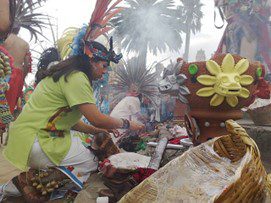Ceres Otero
Mexico City, Mexico

Of the various peoples who inhabited prehispanic Mexico, the Aztecs were the most medically advanced.1 According to their mythological beliefs, divine beings were to be venerated for giving life to humans and for creating on Earth a place where they could fully develop and live in balance with other species.2
Because the health of the people living in these civilizations was thought to give these divine beings pleasure and happiness, the Aztecs thought to achieve this through magical and religious methods.2 When someone fell ill, the doctors would try to find out the cause of the disease. They thought it had been brought on by human envy, anger, or depression; a deity wanting to test their endurance; or that enemies had used witchcraft to make them weaker and easier to defeat.2
Most of the time, these diseases were so hard to treat that chamanes, or wizards, had to be consulted.3 These wizards based their practice on the hypothesis that all people were born from an axis, that excessive cold and heat were the primary causes of disease, and that plants like damiana and zarzaparrilla were useful to treat them.3 They also used corn, the main component of their diet, in anti-inflammatory medication.3
The chamanes used purple maguey to cure facial wounds by washing the affected area with water from boiling the leaves. Additionally, they used ant pincers on lip wounds so that when the ants would bite down, their mandibles would form a suture. Once the bite had occurred, they removed the body, leaving only the head of the ant, and would remove that when the wound was closed.3
When the Spanish arrived in Mexico, many native activities were considered diabolical, and were later changed into safer and more ethical medical techniques. Nonetheless, these wizards and their techniques saved many lives and are worth remembering as part of Mexico’s history.
References
- Urióstegui, Jesús. “Vista de De Médicos y Hechiceros En El México Prehispánico.” Vista de De médicos y hechiceros en el México Prehispánico, 2014. https://revistas.inah.gob.mx/index.php/antropologia/article/view/2906/2807.
- Medios, S.A. de C.V., DEMOS de, Desarrollo. “La Jornada: La Medicina Prehispánica, Un Saber Original y Propio: Experto.” La Jornada, May 15, 2015. https://www.jornada.com.mx/2015/05/15/ciencias/a02n1cie.
- Cisneros, Stefany. “Plantas Medicinales Prehispánicas, ¿para Qué Servían?” México Desconocido, January 26, 2018. https://www.mexicodesconocido.com.mx/plantas-medicinales-prehispanicas.html.
CERES ALHELÍ OTERO PENICHE is a second-year medical school student at Tecnológico de Monterrey in Mexico City. She has a passion for writing and enjoys reading, painting, and visiting museums.

Leave a Reply